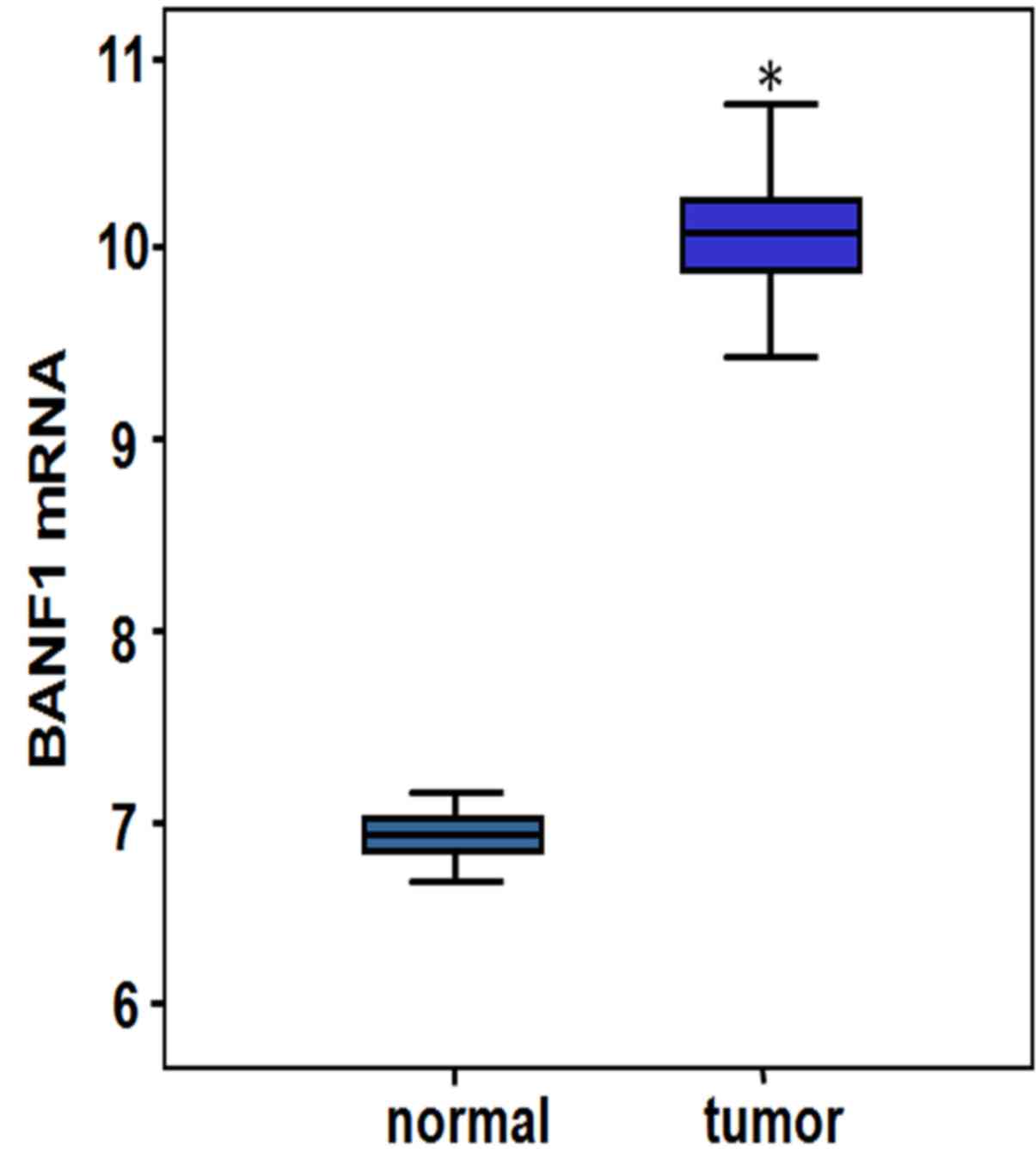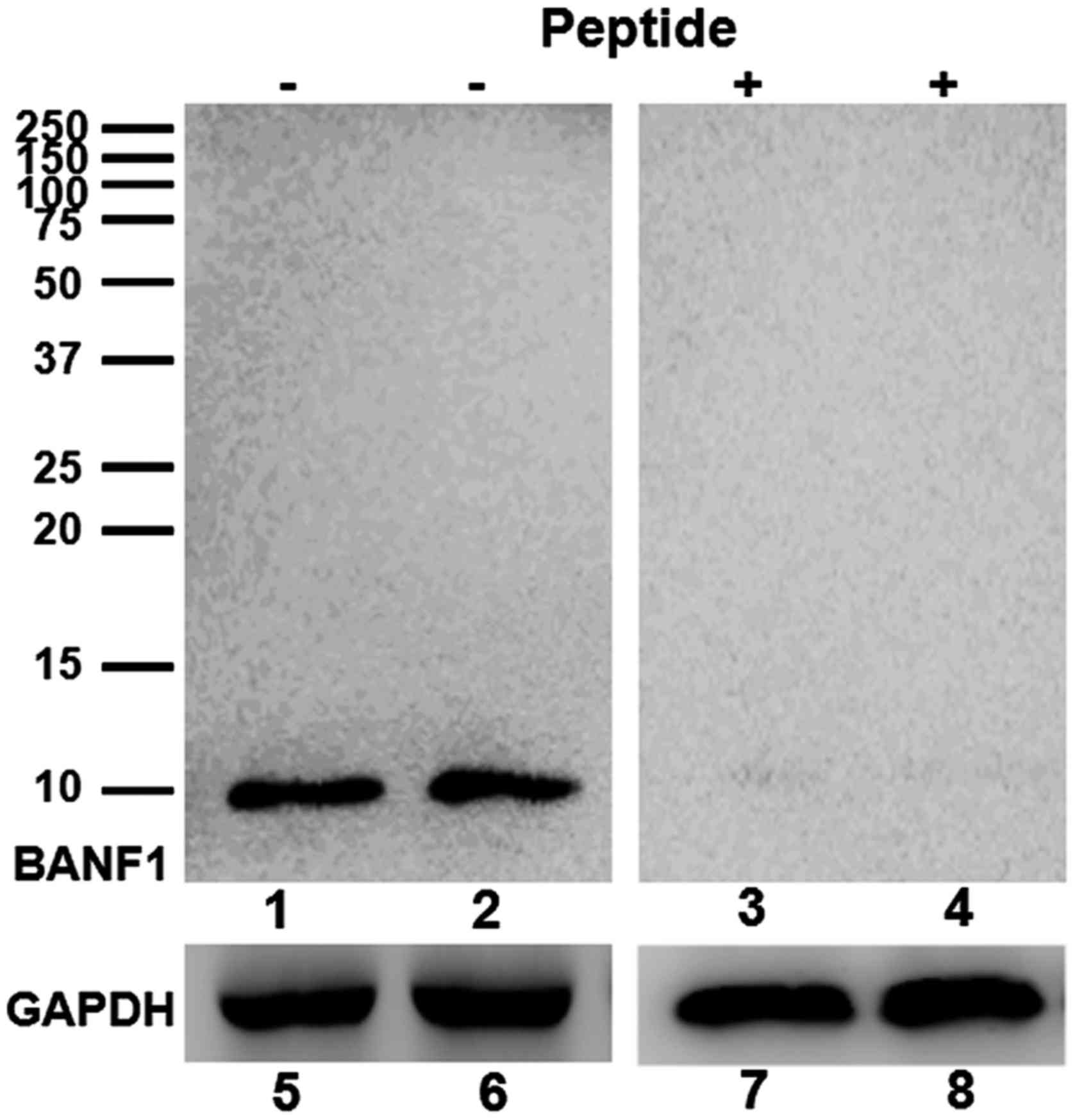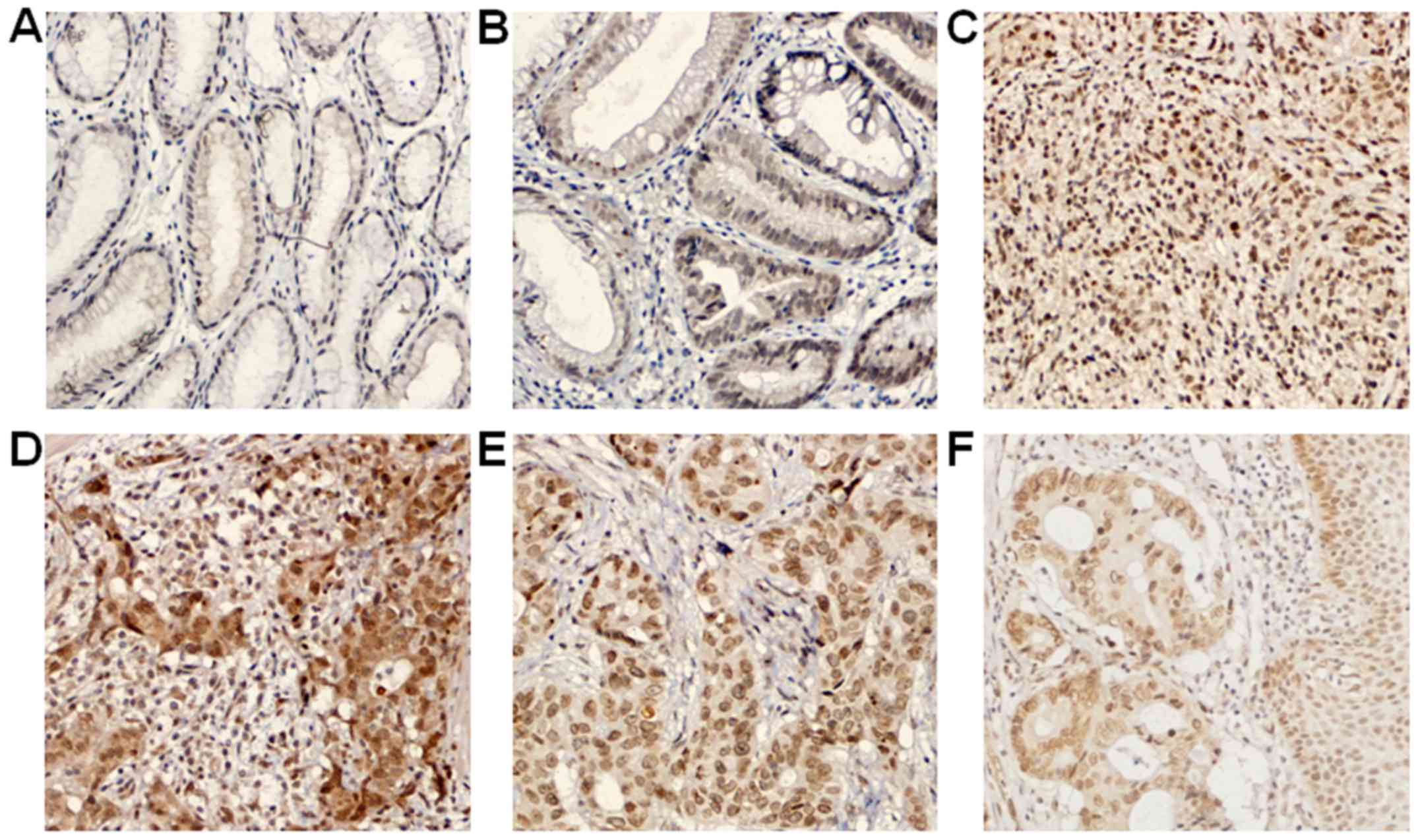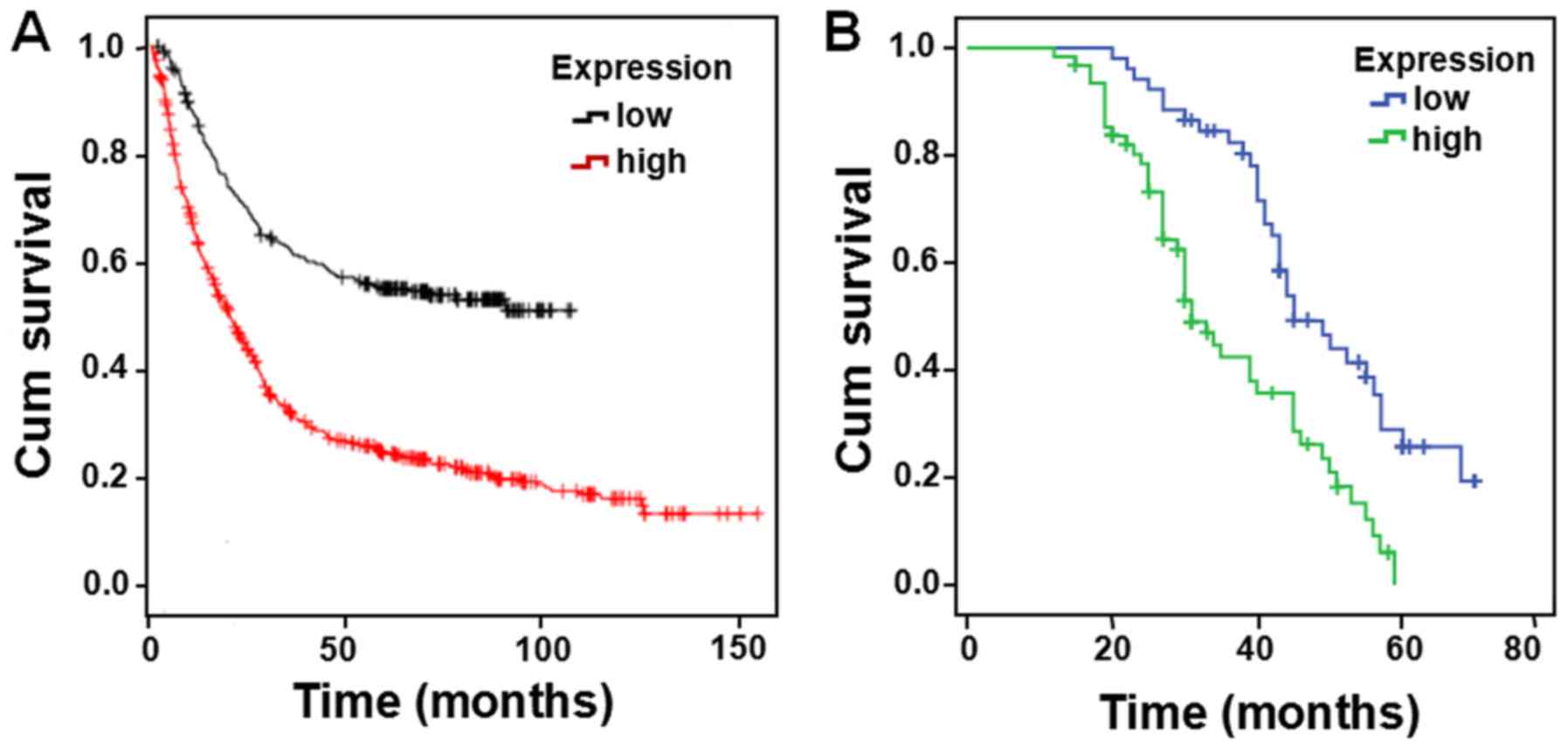|
1
|
Bray F, Jemal A, Grey N, Ferlay J and
Forman D: Global cancer transitions according to the human
development index (2008–2030): A population-based study. Lancet
Oncol. 13:790–801. 2012. View Article : Google Scholar : PubMed/NCBI
|
|
2
|
Chu D, Zhu S, Li J, Ji G, Wang W, Wu G and
Zheng J: CD147 expression in human gastric cancer is associated
with tumor recurrence and prognosis. PLoS One. 9:e1010272014.
View Article : Google Scholar : PubMed/NCBI
|
|
3
|
Sun J, Jiang J, Lu K, Chen Q, Tao D and
Chen Z: Therapeutic potential of ADAM17 modulation in gastric
cancer through regulation of the EGFR and TNF-α signalling
pathways. Mol Cell Biochem. 426:17–26. 2017. View Article : Google Scholar : PubMed/NCBI
|
|
4
|
Shen Q, Eun JW, Lee K, Kim HS, Yang HD,
Kim SY, Lee EK, Kim T, Kang K, Kim S, et al: Barrier to
autointegration factor 1, procollagen-lysine, 2-oxoglutarate
5-dioxygenase 3, and splicing factor 3b subunit 4 as early-stage
cancer decision markers and drivers of hepatocellular carcinoma.
Hepatology. 67:1360–1377. 2018. View Article : Google Scholar : PubMed/NCBI
|
|
5
|
Takama H, Sugiura K, Ogawa Y, Muro Y and
Akiyama M: Possible roles of barrier-to-autointegration factor 1 in
regulation of keratinocyte differentiation and proliferation. J
Dermatol Sci. 71:100–106. 2013. View Article : Google Scholar : PubMed/NCBI
|
|
6
|
Mekhail K and Moazed D: The nuclear
envelope in genome organization, expression and stability. Nat Rev
Mol Cell Biol. 11:317–328. 2010. View
Article : Google Scholar : PubMed/NCBI
|
|
7
|
Hutchison CJ: Lamins: Building blocks or
regulators of gene expression? Nat Rev Mol Cell Biol. 3:848–858.
2002. View
Article : Google Scholar : PubMed/NCBI
|
|
8
|
Brachner A, Braun J, Ghodgaonkar M, Castor
D, Zlopasa L, Ehrlich V, Jiricny J, Gotzmann J, Knasmüller S and
Foisner R: The endonuclease Ankle1 requires its LEM and GIY-YIG
motifs for DNA cleavage in vivo. J Cell Sci. 125:1048–1057. 2012.
View Article : Google Scholar : PubMed/NCBI
|
|
9
|
Pastorino U: Lung cancer screening. Br J
Cancer. 102:1681–1686. 2010. View Article : Google Scholar : PubMed/NCBI
|
|
10
|
Liu JY, Peng CW, Yang XJ, Huang CQ and Li
Y: The prognosis role of AJCC/UICC 8th edition staging system in
gastric cancer, a retrospective analysis. Am J Transl Res.
10:292–303. 2018.PubMed/NCBI
|
|
11
|
Furukawa K: LAP2 binding protein 1
(L2BP1/BAF) is a candidate mediator of LAP2-chromatin interaction.
J Cell Sci. 112:2485–2492. 1999.PubMed/NCBI
|
|
12
|
Sotgia F and Lisanti MP: Mitochondrial
biomarkers predict tumor progression and poor overall survival in
gastric cancers: Companion diagnostics for personalized medicine.
Oncotarget. 8:67117–67128. 2017. View Article : Google Scholar : PubMed/NCBI
|
|
13
|
Molitor TP and Traktman P: Depletion of
the protein kinase VRK1 disrupts nuclear envelope morphology and
leads to BAF retention on mitotic chromosomes. Mol Biol Cell.
25:891–903. 2014. View Article : Google Scholar : PubMed/NCBI
|
|
14
|
Wiebe MS and Jamin A: The barrier to
autointegration factor: Interlocking antiviral defense with genome
maintenance. J Virol. 90:3806–3809. 2016. View Article : Google Scholar : PubMed/NCBI
|
|
15
|
Snyers L, Erhart R, Laffer S, Pusch O,
Weipoltshammer K and Schöfer C: LEM4/ANKLE-2 deficiency impairs
post-mitotic re-localization of BAF, LAP2α and LaminA to the
nucleus, causes nuclear envelope instability in telophase and leads
to hyperploidy in HeLa cells. Eur J Cell Biol. 97:63–74. 2018.
View Article : Google Scholar : PubMed/NCBI
|
|
16
|
Chou W, Ngo T and Gershon PD: An overview
of the vaccinia virus infectome: A survey of the proteins of the
poxvirus-infected cell. J Virol. 86:1487–1499. 2012. View Article : Google Scholar : PubMed/NCBI
|
|
17
|
Samwer M, Schneider MWG, Hoefler R,
Schmalhorst PS, Jude JG, Zuber J and Gerlich DW: DNA cross-bridging
shapes a single nucleus from a set of mitotic chromosomes. Cell.
170:956–972. 2017. View Article : Google Scholar : PubMed/NCBI
|
|
18
|
Haraguchi T, Kojidani T, Koujin T, Shimi
T, Osakada H, Mori C, Yamamoto A and Hiraoka Y: Live cell imaging
and electron microscopy reveal dynamic processes of BAF-directed
nuclear envelope assembly. J Cell Sci. 121:2540–2554. 2008.
View Article : Google Scholar : PubMed/NCBI
|
|
19
|
Kim SH, Lyu HN, Kim YS, Jeon YH, Kim W,
Kim S, Lim JK, Lee HW, Baek NI, Choi KY, et al: Brazilin isolated
from caesalpinia sappan suppresses nuclear envelope reassembly by
inhibiting barrier-to-autointegration factor phosphorylation. J
Pharmacol Exp Ther. 352:175–184. 2015. View Article : Google Scholar : PubMed/NCBI
|
|
20
|
Qi R, Xu N, Wang G, Ren H, Li S, Lei J,
Lin Q, Wang L, Gu X and Zhang H: The lamin-A/C-LAP2α-BAF1 protein
complex regulates mitotic spindle assembly and positioning. J Cell
Sci. 128:2830–2841. 2015. View Article : Google Scholar : PubMed/NCBI
|
|
21
|
Zhuang X, Semenova E, Maric D and Craigie
R: Dephosphorylation of barrier-to-autointegration factor by
protein phosphatase 4 and its role in cell mitosis. J Biol Chem.
289:1119–1127. 2014. View Article : Google Scholar : PubMed/NCBI
|
|
22
|
Margalit A, Neufeld E, Feinstein N, Wilson
KL, Podbilewicz B and Gruenbaum Y: Barrier toautointegration factor
blocks premature cell fusion and maintains adult muscle integrity
in C. elegans. J Cell Biol. 178:661–673. 2007. View Article : Google Scholar : PubMed/NCBI
|
|
23
|
Zheng R, Ghirlando R, Lee MS, Mizuuchi K,
Krause M and Craigie R: Barrier-to-autointegration factor (BAF)
bridges DNA in a discrete, higher-order nucleoprotein complex. Proc
Natl Acad Sci USA. 97:8997–9002. 2000. View Article : Google Scholar : PubMed/NCBI
|
|
24
|
Ibrahim N, Wicklund A, Jamin A and Wiebe
MS: Barrier to autointegration factor (BAF) inhibits vaccinia virus
intermediate transcription in the absence of the viral B1 kinase.
Virology. 444:363–373. 2013. View Article : Google Scholar : PubMed/NCBI
|
|
25
|
Paquet N, Box JK, Ashton NW, Suraweera A,
Croft LV, Urquhart AJ, Bolderson E, Zhang SD, O'Byrne KJ and
Richard DJ: Néstor-guillermo progeria syndrome: A biochemical
insight into barrier-to-autointegration factor 1, alanine 12
threonine mutation. BMC Mol Biol. 15:272014. View Article : Google Scholar : PubMed/NCBI
|
|
26
|
Loi M, Cenni V, Duchi S, Squarzoni S,
Lopez-Otin C, Foisner R, Lattanzi G and Capanni C:
Barrier-to-autointegration factor (BAF) involvement in prelamin
A-related chromatin organization changes. Oncotarget.
7:15662–15677. 2015.
|
|
27
|
Li J, Wang T, Pei L, Jing J, Hu W, Sun T
and Liu H: Expression of VRK1 and the downstream gene BANF1 in
esophageal cancer. Biomed Pharmacother. 89:1086–1091. 2017.
View Article : Google Scholar : PubMed/NCBI
|
|
28
|
Lai TC, Chou HC, Chen YW, Lee TR, Chan HT,
Shen HH, Lee WT, Lin ST, Lu YC, Wu CL and Chan HL: Secretomic and
proteomic analysis of potential breast cancer markers by
two-dimensional differential gel electrophoresis. J Proteome Res.
9:1302–1322. 2010. View Article : Google Scholar : PubMed/NCBI
|
|
29
|
Cox JL, Mallanna SK, Ormsbee BD, Desler M,
Wiebe MS and Rizzino A: Banf1 is required to maintain the
self-renewal of both mouse and human embryonic stem cells. J Cell
Sci. 124:2654–2665. 2011. View Article : Google Scholar : PubMed/NCBI
|
|
30
|
Kim W, Lyu HN, Kwon HS, Kim YS, Lee KH,
Kim DY, Chakraborty G, Choi KY, Yoon HS and Kim KT: Obtusilactone B
from Machilus Thunbergii targets barrier-to-autointegration factor
to treat cancer. Mol Pharmacol. 83:367–376. 2013. View Article : Google Scholar : PubMed/NCBI
|


















